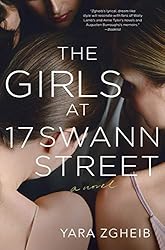Girls at 17 Swann Street (Zgheib)
| Article Index | Summary | Author Bio | Book Reviews | Discussion Questions | Full Version |
|---|
The Girls at 17 Swann Street
Yara Zgheib, 2019
St. Martin's Press
384 pp.
ISBN-13: 9781250202444
Summary
Yara Zgheib’s poetic and poignant debut novel is a haunting portrait of a young woman’s struggle with anorexia on an intimate journey to reclaim her life.
The chocolate went first, then the cheese, the fries, the ice cream. The bread was more difficult, but if she could just lose a little more weight, perhaps she would make the soloists’ list.
Perhaps if she were lighter, danced better, tried harder, she would be good enough. Perhaps if she just ran for one more mile, lost just one more pound.
Anna Roux was a professional dancer who followed the man of her dreams from Paris to Missouri. There, alone with her biggest fears—imperfection, failure, loneliness—she spirals down anorexia and depression till she weighs a mere eighty-eight pounds.
Forced to seek treatment, she is admitted as a patient at 17 Swann Street, a peach pink house where pale, fragile women with life-threatening eating disorders live. Women like Emm, the veteran; quiet Valerie; Julia, always hungry. Together, they must fight their diseases and face six meals a day.
Every bite causes anxiety. Every flavor induces guilt. And every step Anna takes toward recovery will require strength, endurance, and the support of the girls at 17 Swann Street. (From the publisher.)
Author Bio
Yara Zgheib is a Fulbright scholar with a Masters degree in Security Studies from Georgetown University and a PhD in International Affairs in Diplomacy from Centre D'etudes Diplomatiques et Strategiques in Paris. She is the author of The Girls at 17 Swann Street (2019) and writes on culture, art, travel, and philosophy on her blog, "Aristotle at Afternoon Tea."
Zgheib is fluent in English, Arabic, French, and Spanish. She is a writer for several US and European magazines, including The Huffington Post, The Four Seasons Magazine, A Woman’s Paris, The Idea List, and Holiday Magazine. (From the publisher.)
Book Reviews
★ In her powerful debut, Zgheib masterfully chronicles the pain of an anorexic’s distorted thinking and intense fear of food in a riveting diarylike structure.… This is an impressive, deeply moving debut.
Publishers Weekly
Zgheib's lyrical, dream-like style will resonate with fans of Wally Lamb's and Anne Tyler's novels and Augusten Burroughs' memoirs.
Booklist
[T]he novel's greatest strength is its simplicity. There is no unusually dramatic backstory.… Anna is, in all but her Frenchness, unexceptional. It's a story we've read before; it's moving nonetheless. A nuanced portrait of a woman struggling against herself.
Kirkus Reviews
Discussion Questions
We'll add publisher questions if and when they're available; in the meantime, use our LitLovers talking points help start a discussion for THE GIRLS AT 17 SWANN STREET … and then take off on your own:
1. Talk about Anorexia Nervosa (AN) as an illness. What preconceptions of AN did you have prior to reading The Girls of 17 Swann Street? What have you learned that surprises you—symptoms, perhaps, which you were unaware of?
2. Anna says, "I am twenty-six years old. My body feels sixty-two." What does she mean? Ever feel that way?
3. What do readers learn about Anna's background that might have led her to become anorexic? What, for instance, does AN have to with the need for control in ones life … or a lack of self-acceptance?
4. What has the medical/scientific community learned about the causes of AN?
5. What is the difference between Bulimia and Anorexia?
6. How does Anna's disease affect her relationship with her husband?
7. Readers have talked about the authenticity contained in Yara Zgheib's handling of the story. Do you agree? If so, in what makes the novel feel "authentic"?
8. Anna says, “I have books to read, places to see, babies to make, birthday cakes to taste. I even have unused birthday wishes to spare.”
So what am I doing here?”
If you were a friend, or a counselor, to Anna, what would you say to her?
9. Have you, or people you know, suffered from eating disorders? Can you talk about those experiences? How do Anna's experiences compare?
10. Does the book's structure—told through a series of vignettes from Anna's past, as well as her experiences at the treatment center—enhance or disrupt your reading experience? Would you have preferred a more continuous narrative flow? Why or why not?
11. Talk about the other characters' struggles with their illness? Do you find one character more sympathetic than others?
12. How do the other patients at 17 Swann Street help one each other overcome their illnesses? How do they support and learn from one another?
(Questions by LitLovers. Please feel free to use them, online and off, with attribution. Thanks.)
Site by BOOM
![]()
LitLovers © 2024


